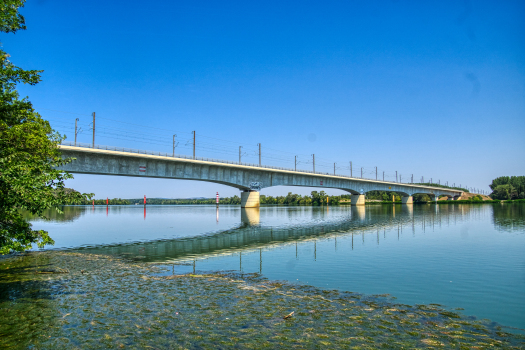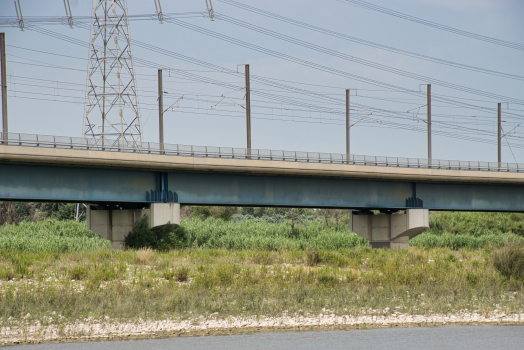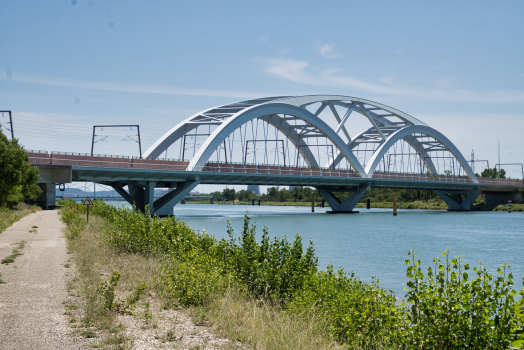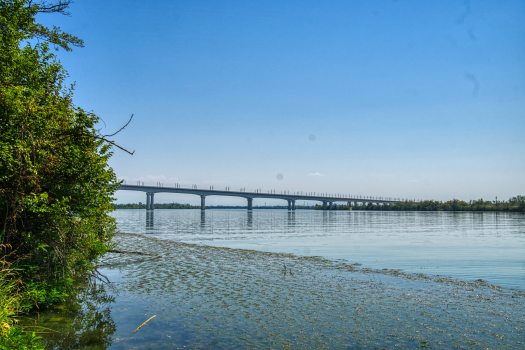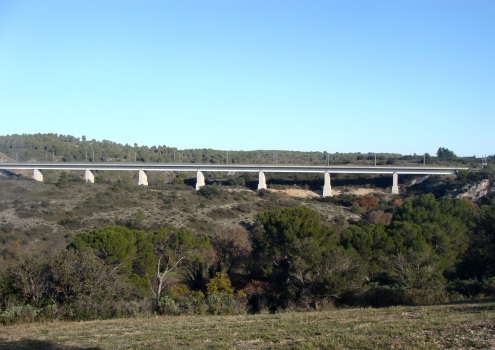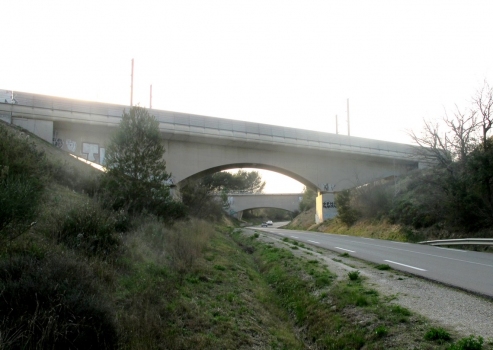General Information
| Name in local language: | Ligne à grande vitesse (LGV) Méditerranée |
|---|---|
| Official designation: | Ligne nouvelle 5 (LN 5) |
| Beginning of works: | 1995 |
| Completion: | 7 June 2001 |
| Status: | in use |
Project Type
| Function / usage: |
High-speed rail line |
|---|
Location
| km | Name |
| 10.980 | |
| 15.100 | |
| 18.380 | |
| 495.460 | |
| 522.550 | |
| 531 | |
| 531.620 | |
| 570.210 | |
| 589.200 | |
| 590.300 | |
| 597.860 | |
| 608.100 | |
| 608.640 | |
| 609.300 | |
| 622.400 | |
| 625.160 | |
| 636.200 | |
| 636.940 | |
| 646.600 | |
| 650.560 | |
| 653.800 | |
| 669 | |
| 670.440 | |
| 673.993 | |
| 688.200 | |
| 699.140 | |
| 702.280 | |
| 703.810 | |
| 704.210 | |
| 709.620 |
Technical Information
Dimensions
| total length | 250 km | |
| number of new stations | 3 | |
| number of structures | 483 | |
| length of viaducts | 17 155 m | |
| underground length | 12 768 m |
Quantities
| ballast | 2 400 000 t | |
| number of traverses | 850 000 |
Design Loads
| design speed | 300 km/h |
Cost
| cost of construction | French Franc 24 200 000 000 |
Chronology
| January 1989 | Beginning of studies. |
|---|---|
| January 1991 | The Transport Ministry decides on the track alignment and begins studies for the inquiry for the public inserts of the project. |
| 23 September 1993 | Interdepartmental committee confirms the construction of the line. |
| 31 May 1994 | Project declared of public interest. |
| May 1999 | First tracks laid. |
| 10 June 2001 | Official opening to regular traffic. |
Notes
Continuation of the TGV Paris-South East and TGV Rhône south of Lyons.
Excerpt from Wikipedia
The LGV Méditerranée (French: Ligne à Grande Vitesse; English: high-speed line) is a 250 kilometre-long (160 miles) French high-speed rail line running between Saint-Marcel-lès-Valence, Drôme and Marseille, Bouches-du-Rhône, also featuring a connection to Nîmes, Gard (west of the line).
It connects the regions of Provence-Alpes-Côte d'Azur and Occitanie to the LGV Rhône-Alpes, and from there to Lyon and the north of France. Construction costs rose to €3.8 billion; the line entered service in June 2001 following an inauguration by President Jacques Chirac. The commencement of service on this line has led to a reversal of the respective airplane and train markets: by making Marseille reachable in three hours from Paris—a distance of over 750 kilometres (470 miles)—the train now handles two thirds of all journeys on that route.
Route
The LGV Méditerranée begins in the southeast at Saint-Marcel-lès-Valence, as the extension of the LGV Rhône-Alpes. The new Gare de Valence TGV lies at the interchange with the regular Valence-Grenoble line, allowing rapid connections towards Valence, Romans-sur-Isère and Grenoble. At Crest, an emergency link is provided to the Briançon-Loriol line. The LGV then approaches the Rhône, rejoining the A7 autoroute at Montélimar. After crossing the Canal de Donzère-Mondragon, the line connects to the regular network by an emergency link situated between Pierrelatte and Lapalud.
Spanning the Rhône three times (twice at Mornas, once north of Roquemaure), the LGV continues to Angles, where a triangle allows access to the southwest and southeast. The southwest branch is generally thought of as the beginning of a future LGV Languedoc-Roussillon, joining the regular Avignon-Nîmes line 25 kilometres (16 mi) later at Redessan; there are plans to construct a Contournement ferroviaire de Nîmes et Montpellier. The southeast branch crosses the Rhône again on two parallel viaducts and serves the new Avignon-TGV station, then follows the Durance which it crosses at Orgon.
At Ventabren, a 1.73 kilometres (1.07 mi) viaduct extends across the A8 autoroute, the D10 and the Canal de Provence. The line then dives southward, serving the new Aix-en-Provence-TGV station, traverses the 8 kilometres (5.0 mi) long Tunnel de Marseille and re-joins the regular network at the entry to Marseille.
Stations
Overall TGV system map showing the route of the LGV Méditerranée and connections with other lines.
- Gare de Valence TGV at Saint-Marcel-lès-Valence; a unique two-level station (below, TGVs; above, TERs) which allows rapid connections towards Valence, Grenoble and Romans-sur-Isère
- Gare d'Avignon TGV south of Avignon; its proximity to the city centre has ensured its popularity. A enhancement to the station allowed it to be served by local services connecting to Avignon's central station, amongst others.
- Gare d'Aix-en-Provence TGV near the Réaltor reservoir, halfway between Aix-en-Provence and Marseille Airport; this station has proved more popular than expected and serves the north of the Marseille area. It is also recommended by agents for ships in Fos-Lavera-Port de Bouc, in preference to Marseille. The station has a road connection to Aix-en-Provence, but no classic rail connection as with Valence TGV.
Controversy
- Numerous protests, particularly from well connected wine growers of the Rhône Valley, made President Mitterrand force alterations to the route; the original path would have kept to the left bank of the river, while the final route skirts the river and crosses it four times, at a significantly higher cost.
- The nearly 250 kilometres (160 mi) long line currently has no regularly used connection to the classic network (unless one considers the southwest branch as a connector). Numerous connections had however been proposed:
- a link at Saint-Marcel-lès-Valence between the LGV (southwards) and the regular line (eastwards), accompanied by the electrification of the Valence-Grenoble line. This would permit direct connections between Grenoble and the Mediterranean; instead, passengers traveling between Marseille and Grenoble must change at Valence-TGV; with the Valence to Geneva line through Grenoble now electrified, this link becomes more attractive and a connection is considered for the near-future; another link from the LGV (southwards) to the regular line (towards Valence) would have enabled service to Valence central station from the south;
- a link at Roquemaure from the north towards Avignon would not only have enabled service to Avignon central station, but would have enabled faster service for Arles. A link south of Avignon would equally have permitted the linking of Avignon central station with Marseille in 25 minutes
- the regular use of the existing link at Pierrelatte would have enabled rapid service to Orange from the north, as well as Avignon and Arles, given that no link was created at Roquemaure
- a link at Orgon with the Avignon-Miramas line via Cavaillon would have enabled service to Salon-de-Provence, Miramas and Istres from the north
- Montélimar wanted a TGV station. This would offer the advantage of being able to serve the town with TGV services travelling further south, but Montélimar is currently served by various TGV services leaving the high-speed line just before Valence TGV station.
- Aix-en-Provence wanted its TGV station more eastwards, closer to the town centre.
Journey times
From Paris
- Paris–Lyon-Saint Exupéry Airport: 1:50
- Paris–Valence: 2:16
- Paris–Avignon: 2:40
- Paris–Aix en Provence: 2:55
- Paris–Marseille: 3:00
- Paris–Toulon: 3:55
- Paris–Hyères: 4:15
- Paris–Fréjus: 4.40
- Paris–Nice: 5.35
- Paris–Nîmes: 2:55
- Paris–Montpellier: 3:15
- Paris–Béziers: 4:03
- Paris–Perpignan: 4:45
Interregional
- Lyon–Marseille: 1:40
- Lyon–Toulouse: 4.30
- London-Marseille: 6.28
- Lille–Nice: 7:09
- Metz–Nice: 9:15
- Geneva–Marseille: 3.30
Text imported from Wikipedia article "LGV Méditerranée" and modified on July 22, 2019 according to the CC-BY-SA 4.0 International license.
Participants
-
Architecture et Ouvrages d'art
- Alain Montois (architect)
- Baudin-Châteauneuf
- Bouygues Construction
- Campenon Bernard
- Cimolai Costruzioni Metalliche
- Dodin
- Fougerolle
- Groupe Razel
- GTM Construction
- Secométal S.A.
- Spie Batignolles TP
Relevant Web Sites
Relevant Publications
- (2003): Civil engineering structures over the karstic zone crossed by the TGV Mediterranean Line. Presented at: IABSE Symposium: Structures for High-Speed Railway Transportation, Antwerp, Belgium, 27-29 August 2003, pp. 238-239.
- (1999): La conception des ponts-rails métalliques et mixtes de la ligne TGV-Méditerranée. In: Bulletin ponts métalliques, n. 19 ( 1999), pp. 11-28.
- (2001): Le confortement du déblai TGV à Chabrillan (Drôme). Moyens exceptionnels pour délai exceptionnel. In: Travaux, n. 780 (November 2001), pp. 70-77.
- (1999): Des Records et des Hommes. TGV Méditerranée. Terre du Sud, pp. 192.
- (2001): Des Techniques et des Hommes. TGV Méditerranée. Terre du Sud, pp. 192.
- About this
data sheet - Structure-ID
10000002 - Published on:
18/05/1999 - Last updated on:
14/08/2023

